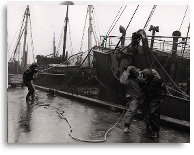Fishermen secure a trawler in Boston during Hurricane Edna, 1954.
Copyright United Press.
Reference 4-1-1-1-161, 0514.
 | |
Inside Fireman's Fund's new home office at 3333 California Street, San Francisco, 1957.
Copyright Gabriel Moulin, San Francisco.
Reference 4-1-3-6-125, 0428.
 |
|
- 1950
- Premiums written: $119,936,000.
- November, disastrous wind storms in the northeast cause damage of $125,000,000.
- Marine cargo insurance decreases due to restrictions placed on imports by foreign nations. Inland marine insurance business increases indicating general prosperity of the nation.
- A Savings and Supplemental Retirement Income Plan is added to the employee benefit program.
- Fireman's Fund appoints an educational director to orient new employees and provide on-the-job training for staff members.
- 1951
- Premiums written: $140,125.000
- Marine and automobile insurance are profitable, whereas bodily injury, property damage, compensation and other casualty lines are unprofitable.
- Fireman's Fund introduces the United States' first Standard Homeowners Policy (SHO), an all risk, continuous term policy for owner-occupied dwellings in California.
- Fireman's Fund publishes the first issue of The Visiting Fireman to enhance communication between management and employees.
- 1952
- Premiums written: $146,155,000.
- Automobile bodily injury and property damage, compensation, general liability and other casualty lines produce the largest underwriting loss suffered by the Fireman's Fund Indemnity Company.
- Fire and allied lines work together to develop single contracts designed to offer homeowners the protection they received previously through the purchase of individual policies.
- Fireman's Fund records underwriting losses in casualty and surety for the third straight year.
- Fireman's Fund and other insurance companies share the adverse effects of the growing number and severity of automobile accidents.
- Fireman's Fund staff numbers 4,000.
- A public information effort encourages Fireman's Fund producers to communicate the risks of auto travel to the public through radio commercials, direct mailing and news ads.
- 1953
- Premiums written: $147,806,000.
- Fireman's Fund records underwriting profits in all major classifications. Underwriting profits in automobile insurance is attributed to an increased awareness by the American public of their responsibilities as drivers.
- Fireman's Fund records profits in casualty and surety insurance in all areas except accident and health.
- Fireman's Fund introduces its first commercial line of insurance with a Group Medical Expense Plan.
- Western National Insurance Company, the reinsurance arm of the company, merges with Fireman's Fund.
- "Production for Profit", a sales kit, is distributed for the first time. It contains technical and sales information and programs on the fidelity and surety business.
- 1954
- Premiums written: $191,011,000.
- SHO (Standard Homeowners Policy) is introduced nationwide.
- The industry adopts Fireman's Fund's exclusive homeowners policy "all risks" approach.
- Hurricanes Carol, Edna and Hazel hit the East coast causing losses estimated at $300,000,000. Fireman's Fund handles 44,000 claims involving a gross loss of $11,000,000.
- Fireman's Fund purchases National Surety Corporation.
- A program of recapitalization increases the number of outstanding shares which are sold across the country and produce a $33,000,000 increase in capital funds and a 20 percent stock dividend.
- The Fireman's Fund Foundation is founded to assist worthy charities.
- Fireman's Fund insurance is sold by 27,500 independent agents and brokers.
- Fireman's Fund initiates a "Home Study Course" to acquaint agents with technical issues and sales opportunities.
- The Fireman's Fund Record changes from an in-house publication to an advertising and public relations tool for agents.
- Fireman's Fund introduces Blanket Medical Expense Plan.
- 1955
- Premiums written: $204,098,000.
- Fireman's Fund realigns its territorial operations. Three new multiple line territorial divisions are established including the Eastern Department in New York, the New England Department in Boston and the Southwestern Department in Dallas.
- Fireman's Fund establishes the Electronic Applications Division to initiate and continue research with respect to the potential applications of electronic data processing equipment in the business.
- Fireman's Fund staff totals 5,982; of which 463 have served the company for 25 years or more. Many belong to the Fireman's Fund Pioneers.
- The Fireman's Fund Foundation makes contributions to Stanford University for support of a general insurance course.
- Work is started on the Home Office Headquarters at 3333 California Street, San Francisco.
- 1956
- Premiums written: $216,236,000.
- Fireman's Fund suffers its largest underwriting loss ever. The country's property loss for the year approaches $1,000,000,000 due to two major transportation disasters -- the collision of two jet liners over the Grand Canyon and the collision of the Andrea Doria and the Stockholm in which 51 lives were lost.
- The company officially begins using the name "The Fund Insurance Companies."
- The Excess and Special Risk Department begins operations.
- 1957
- Premiums written: $255,664,000.
- Hurricane Audrey hits the southwest.
- June: Fireman's Fund moves into its new headquarters at 3333 California Street on Laurel Heights in San Francisco.
- 1958
- Premiums written: $230,512,000.
- Fireman's Fund experiences some improvement in underwriting results from the past two years but underwriting is still unsatisfactory.
- Fireman's Fund introduces a low cost automobile insurance program called Economy Plus Automobile Insurance for Safe Drivers.
- Fireman's Fund establishes a Research, Development and Sales Department to explore new ways to strengthen the position of agents and to coordinate decisions relating to the improvement of production facilities.
- Fireman's Fund introduces a new professional training program, which is designed to make career opportunities at Fireman's Fund more attractive.
- Fireman's Fund introduces the "Fund/65 Plan" providing low-cost hospital and surgical benefits to people age 65 or older.
- 1959
- Premiums written: $258,195,000.
- Fireman's Fund Indemnity Company, a subsidiary of Fireman's Fund, merges with the company.
|